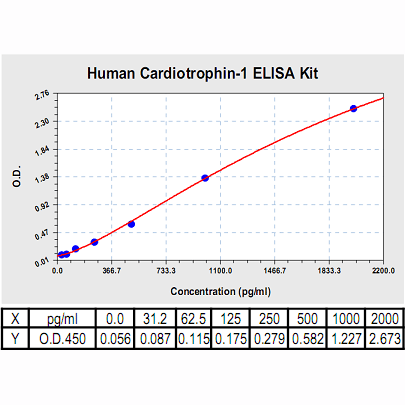Cardiotrophin-1 ELISA Kit, Human |
 |
BACKGROUND Cardiotrophin-1 (CT-1) is a naturally occurring protein member of the IL-6 family of cytokines with a molecular mass of 21.5 kDa. Like leukemia inhibitory factor (LIF), CNTF, and oncostatin M (OSM), CT-1 signals via the LIFRbeta/gp130 receptor complex and a third specific receptor component (CT-1Ralpha).1 gp130 is common to the receptor complex of other members of IL-6 superfamily and is required for both ligand binding and signal transduction. CT-1 was originally identified as a cardiac myocyte hypertrophic factor, which can induce in vitro hypertrophy and survival signals in neonatal and adult cardiomyocytes. It also shares biological activities of the IL-6 members, i.e., on hematopoietic cells, embryonic stem cells, hepatocytes, and neuronal cells. In particular, CT-1 is a very potent neurotrophic factor for spinal motoneurons in long-term culture and protects neonatal sciatic motoneurons from axotomy-induced cell death in rats. Furthermore, CT-1 may be a naturally relevant neurotrophic factor for developing motoneurons, as it is present at high levels in embryonic limb bud in vivo. CT-1 activates cell survival signaling pathways including STAT3, extracellular-regulated kinase (Erk)1/2, and protein kinase B (Akt).2
CT-1 mRNA expression has been detected at high levels in heart, skeletal muscle, prostate, ovaries, and liver, as well as fetal heart, lung, and kidney, and in lower amounts in other tissues. It has been reported that CT-1 gene expression is increased in ventricular myocardium after myocardial infarction (MI) and in hypertensive rats. And cardiac CT-1 gene expression is activated in both canine atrial and ventricular myocardium in experimental congestive heart failure. Thus, CT-1 may have an important role in the development of cardiac hypertrophy and heart failure. In addition, Adipose tissue has emerged as a key secretory organ, with the ability to secrete different adipokines, including IL-6. It has been shown that adipocytes express gp130 and LIFR and respond to IL-6 family cytokines, including CT-1. Moreover, CT-1 expression progressively increased, along with differentiation time from preadipocyte to mature adipocyte in 3T3-L1 cells. CT-1 expression was enhanced by glucose in a dose-dependent manner in these cells.3 Furthermore, CT-1 appears to be a mediator of impaired insulin sensitivity, as chronic administration of CT-1 to 3T3-L1 adipocytes resulted in a decrease in insulin-stimulated glucose uptake.4
CT-1 mRNA expression has been detected at high levels in heart, skeletal muscle, prostate, ovaries, and liver, as well as fetal heart, lung, and kidney, and in lower amounts in other tissues. It has been reported that CT-1 gene expression is increased in ventricular myocardium after myocardial infarction (MI) and in hypertensive rats. And cardiac CT-1 gene expression is activated in both canine atrial and ventricular myocardium in experimental congestive heart failure. Thus, CT-1 may have an important role in the development of cardiac hypertrophy and heart failure. In addition, Adipose tissue has emerged as a key secretory organ, with the ability to secrete different adipokines, including IL-6. It has been shown that adipocytes express gp130 and LIFR and respond to IL-6 family cytokines, including CT-1. Moreover, CT-1 expression progressively increased, along with differentiation time from preadipocyte to mature adipocyte in 3T3-L1 cells. CT-1 expression was enhanced by glucose in a dose-dependent manner in these cells.3 Furthermore, CT-1 appears to be a mediator of impaired insulin sensitivity, as chronic administration of CT-1 to 3T3-L1 adipocytes resulted in a decrease in insulin-stimulated glucose uptake.4
REFERENCES
1. Tsuruda, T. et al: Circulation Res 90:128-34, 2002
2. Iñiguez, M. et al: J. Exp. Med. 203:2809-15, 2006
3. Natal, C. et al: Am. J. Physiol. Endocrinol. Metab. 294:E52-E60, 2008
4. Zvonic, S. et al: J. Biol. Chem. 279:47572–9, 2004
2. Iñiguez, M. et al: J. Exp. Med. 203:2809-15, 2006
3. Natal, C. et al: Am. J. Physiol. Endocrinol. Metab. 294:E52-E60, 2008
4. Zvonic, S. et al: J. Biol. Chem. 279:47572–9, 2004
Products are for research use only. They are not intended for human, animal, or diagnostic applications.
Документы
Информация представлена исключительно в ознакомительных целях и ни при каких условиях не является публичной офертой








